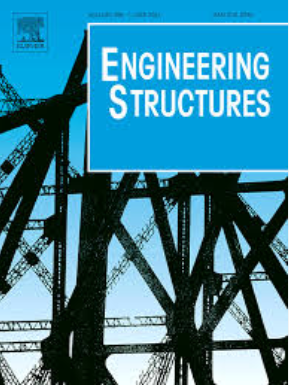The ODE-driven isogeometric level set method with the parameterization for structural dynamic topology optimization problems
IF 6.4
1区 工程技术
Q1 ENGINEERING, CIVIL
引用次数: 0
Abstract
Structural dynamic performance is a critical factor in the optimization to determine the overall distribution of materials. Recently, the isogeometric analysis has drawn significant attention due to its ability to improve numerical precision and stability for structural dynamics. In the current work, the intention is to propose a novel isogeometric level set method with the parameterization for structural dynamic topology optimization problems, mainly including the maximization of eigenfrequency, the minimization of frequency responses and the minimization of dynamic compliance. Firstly, the Level Set Function (LSF) is parametrized with Non-Uniform Rational B-Splines (NURBS) basis functions to decouple the time and space variables, such that the Hamilton-Jacobi Partial Differential Equations (H-J PDEs) can be converted to a number of Ordinary Differential Equations (ODEs). Secondly, the same NURBS basis functions are applied to construct the finite space for unknown structural responses in structural dynamic analysis to maintain the consistency and improve numerical stability. Thirdly, the evolution strategy along the z-direction is considered here to update the level set function with parameterization, which can effectively eliminate the strong dependency of the level set method on the initial designs, particularly the initial distribution of holes. Finally, three different mathematical formulations for eigenfrequency, frequency response and dynamic compliance are developed, in which the related sensitivity analysis is derived in detail. Several numerical examples in 2D and 3D are developed to study the effectiveness of the proposed ODE-driven isogeometric level set method.
基于参数化的ode驱动等几何水平集方法求解结构动态拓扑优化问题
结构动力性能是确定材料整体分布优化的关键因素。等几何分析由于能够提高结构动力学的数值精度和稳定性,近年来引起了人们的广泛关注。在目前的工作中,目的是提出一种具有参数化的结构动态拓扑优化问题的新颖等几何水平集方法,主要包括特征频率的最大化、频率响应的最小化和动态柔度的最小化。首先,利用非均匀有理b样条(NURBS)基函数对水平集函数(LSF)进行参数化,实现时间和空间变量的解耦,使Hamilton-Jacobi偏微分方程(H-J PDEs)可以转化为若干常微分方程(ode);其次,采用相同的NURBS基函数构造结构动力分析中未知结构响应的有限空间,保持一致性,提高数值稳定性;第三,考虑沿z方向的演化策略,对水平集函数进行参数化更新,有效地消除了水平集方法对初始设计特别是孔洞初始分布的强依赖性。最后,提出了三种不同的特征频率、频率响应和动态柔度的数学表达式,并详细推导了相关的灵敏度分析。通过二维和三维的数值算例,研究了该方法的有效性。
本文章由计算机程序翻译,如有差异,请以英文原文为准。
求助全文
约1分钟内获得全文
求助全文
来源期刊

Engineering Structures
工程技术-工程:土木
CiteScore
10.20
自引率
14.50%
发文量
1385
审稿时长
67 days
期刊介绍:
Engineering Structures provides a forum for a broad blend of scientific and technical papers to reflect the evolving needs of the structural engineering and structural mechanics communities. Particularly welcome are contributions dealing with applications of structural engineering and mechanics principles in all areas of technology. The journal aspires to a broad and integrated coverage of the effects of dynamic loadings and of the modelling techniques whereby the structural response to these loadings may be computed.
The scope of Engineering Structures encompasses, but is not restricted to, the following areas: infrastructure engineering; earthquake engineering; structure-fluid-soil interaction; wind engineering; fire engineering; blast engineering; structural reliability/stability; life assessment/integrity; structural health monitoring; multi-hazard engineering; structural dynamics; optimization; expert systems; experimental modelling; performance-based design; multiscale analysis; value engineering.
Topics of interest include: tall buildings; innovative structures; environmentally responsive structures; bridges; stadiums; commercial and public buildings; transmission towers; television and telecommunication masts; foldable structures; cooling towers; plates and shells; suspension structures; protective structures; smart structures; nuclear reactors; dams; pressure vessels; pipelines; tunnels.
Engineering Structures also publishes review articles, short communications and discussions, book reviews, and a diary on international events related to any aspect of structural engineering.
 求助内容:
求助内容: 应助结果提醒方式:
应助结果提醒方式:


